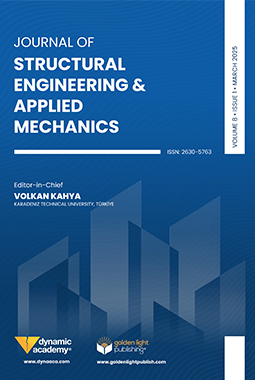ISSN:2630-5763
Journal of Structural Engineering & Applied Mechanics
ARTICLES
Barbaros Atmaca
Şevket ATEŞ
Murat GÜNAYDIN
To determine the dynamic characteristics of bridges with prestressed girders, their natural frequencies and mode shapes used to construct the superstructure must be known. However, there is no agreement among scientists on how prestress force affects the dynamic characteristics of a precast prestressed girder. The purpose of this paper is to obtain the dynamic characteristics of prestressed concrete girders through analytically, numerically, and operational modal testing. For this purpose, one of a typical precast I-girder with 1.2 m height and 27.45 m effective span length is selected as a numerical application. The three-dimensional (3D) finite element model (FEM) of the girder is modeled by SAP2000. Experimental measurements of the girder were conducted at the construction site by the operational modal testing method. For experimental measurements, ten uniaxial seismic accelerometers were mounted at the top flange of the PSC girder in the x- and z-direction. The vibrations that occur from the movement of trucks and cranes at the construction site and the impact of the hammer were measured by these accelerometers as acceleration. The measured signal was collected at the data bank and then sent to the computer equipped with Operational Modal Analysis software which used Enhanced Frequency Domain Decomposition and Stochastic Subspace Identification techniques. The dynamic behaviors of girder were derived from analysis performed by this software. At the end of the study, the dynamic characteristic was obtained by the analytical prediction, numerical and experimental were compared with each other. It is seen that natural frequencies and mode shapes obtained from theoretical prediction, numerical and operational modal testing are not too far apart.
https://doi.org/10.31462/jseam.2022.01001012
Ahmet Tuğrul TOY
Barış SEVİM
This paper aims to present blasting effects on the structural response of a 5-story building considering its columns, shear walls, beams, slabs, raft foundation, masonry walls, and windows. A building with a geometry of 12×20 m in plan and a height of 15.5 m is considered. The three-dimensional finite element model of the building is constituted using ANSYS Workbench and blasting analysis is explicitly performed in ANSYS AUTODYN. TNT is exploded to give blasting effects on the structure. The duration of the explosion is set to 3-msec. Stresses, displacements, material status, and pressures due to blasting on some gauge points are presented. It is seen from the study that the blast causes local damage to the load-bearing elements.
https://doi.org/10.31462/jseam.2022.01013021
Merve Ermis
Gokay Aydogan
Oguzhan Kir
Umit Necmettin Aribas
Mehmet Hakkı Omurtag
The objective of this study is to investigate the behavior of the static and free vibration analyses of axially functionally graded elliptical planar curved beams using a mixed finite element method (MFEM) based on the Timoshenko beam theory. A two-noded curved mixed finite element has 12 field variables at each node. These variables denote three displacements, three cross-sectional rotations, three forces, two bending moments, and torque, respectively. The functionally graded material is composed of ceramic-particle material and metal-matrix material. The volume fraction of ceramic and metal materials varies along the beam axis. The effective material properties (modulus of elasticity, Poisson's ratio, and density) of the functionally graded material are determined according to the rule of mixture. It is aimed in the benchmark examples to present the influence of ceramic-particle material and non-homogeneity index of material gradation, the minimum radius of the elliptical beam, and boundary condition to the results of static and free vibration analysis in detail.
https://doi.org/10.31462/jseam.2022.01022039
Tuna Ulger
Muhammet Karabulut
Necati Mert
Reinforced concrete buildings, which constitute most of the building stock in Turkey, should be examined in terms of earthquake resistance. Many studies have been carried out to increase the seismic resistance of reinforced concrete (RC) structures against earthquakes. In this study, a single-story, single-span RC frame stiffened with chevron steel braces was chosen as a reference frame and laterally loaded to failure. In the first step, the experimentally obtained static lateral load-deflection curve was verified by non-linear finite element (FE) analysis. Then, the uniaxial tensile properties of the selected glass fiber reinforced polymer (GFRP) materials were verified using FE analysis with the results found in the literature. In the second step, three different GFRP box braces with different axial stiffnesses were investigated and the results were compared with those of the steel chevron braces. Finally, the lateral load performance and expected buckling failure of the GFRP box braces in an RC moment frame have been presented and discussed in this study. Considering the lightweight of the GFRP sections, the lateral load capacity of the RC frame with GFRP braces was improved as much as the steel braces, and the maximum gain was about 47% more when the equal axial stiffness of steel brace was provided to GFRP brace. Ductility and story drift of the considered braced moment frames are presented.
https://doi.org/10.31462/jseam.2022.01040049


